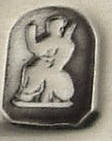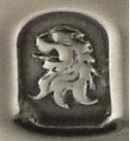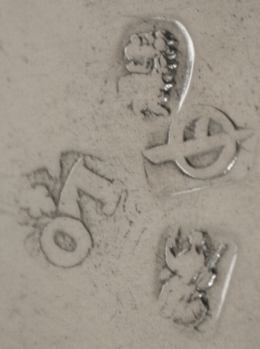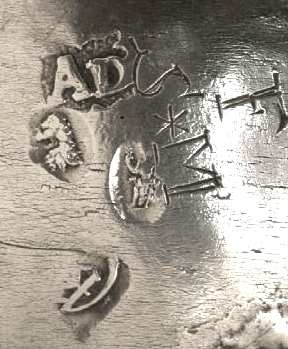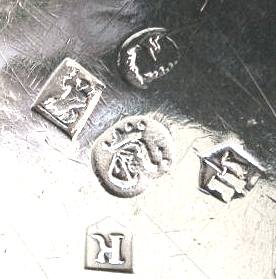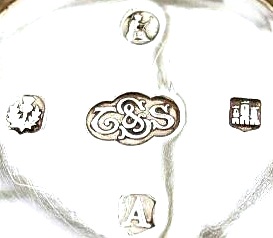by Giovanni
Ciceri
(click on photos to enlarge image)
"BRITANNIA" SILVER STANDARD HALLMARKS IN GREAT BRITAIN
The Britannia silver standard (95,84% of fine silver)(note
1), was introduced by a 1697 Parliament's Act signed by
William III to replace sterling silver (92,5% of fine silver) as
the mandatory standard for items of wrought plate. The decision
was taken to limit the practice of clipping and melting
sterling silver coinage (which standard was maintained to
sterling) to make silverware. This behaviour had its origin
during the reign of Charles II (after the "restoration"), owing
to of the largely increased request of fashioned silver for
luxury and ostentation purposes (note
2).
The change of the "standard" required the change of the
hallmarks. The "lion passant guardant" denoting sterling
standard was replaced with the female figure, commonly called
"Britannia". The "leopard's head" mark of the Worshipful
Company of Goldsmiths (identifying the London Assay Office, but
used in many provincial offices together with their proper town
mark) was replaced with a "lion's head erased" (note
3)
Moreover, any silversmith was required to register a new maker's
mark composed by the first two letters of his surname (instead
of the initials of forename and surname, single initial or a
device previously used).
The "Britannia standard" alloy was softer, less robust
and a little more expensive compared to "sterling standard".
Many silversmiths immediately began to lobby for the
reintroduction of the "sterling standard", but many
Huguenot silversmiths who, because of their origin, were familiar with
the higher standard used in France (95 % fine silver),
petitioned for its retention. Furthermore, the maintaining of "Britannia
standard" allowed the export of English silver to France (while
this practice was not allowed with "sterling" silver which
was below the standard authorized in France).
"Britannia standard", compulsory from 1697 to 1720, did
not produce any significant effect, and the "sterling
standard" on silverware production was restored on 1 June 1720
((note 4).
The restoration of the "sterling standard" ensued in the
adoption of former hallmarks used prior 1697 ("lion passant
guardant" and "crowned leopard head"). However, "Britannia
standard" was not abolished and remained in use also after
1720 as a voluntary alternative option to the "sterling
standard". It was rarely used for making silverware after
1720 and usually only for high level reproduction of antique
items.
After 1720 silversmiths maintained the use the their former
maker's marks (initials) for works in "sterling" silver
standard while the later system of hallmarking (first two
letters of the surname) was used for works in "Britannia
standard".
The practice of using two sets of marks continued until 1739. At
this date, due to the confusion which had arisen, plate workers
were ordered to destroy their existing marks and register a new
one composed by the initials of their Christian name and surname,
choosing letters of different character from those previously
used (note 5).
The "Britannia standard" had a revival in the
reproduction of antique items in the late Victorian Era (late
19th century), during the reigns of Edward VII and George V
(first third of the 20th century) and in more recent years
(1960's and 1970's).
After the hallmarking system change (1 January 1999) "Britannia"
silver is marked with the millesimal fineness hallmark "958",
associated, on an optional and voluntary basis, with the "Britannia"
symbol.
The marks of "Britannia" and the "lion head erased"
had only slight changes over time so that the dating of items
manufactured using these standards depends especially on the "date
letter" (representing the year in which the object was verified
by the Assay Office) and on the maker's mark initials (modified in
1739, when new criteria were introduced).
IDENTIFYING BRITANNIA STANDARD HALLMARKS
Britannia standard silver is hallmarked with the "lion head
erased" (which substituted the "crowned leopard head")
and the "Britannia" (which substituted the "lion
passant guardant")
|
|
|
|
Britannia, standard mark for silver
fineness of 95,84 % (compulsory between 1687 and
1720)
|
Lion head erased, in use as London
Mark for silver of Britannia standard
|
The spoons represent most of the items marked "Britannia"
(1696 - 1720, when the use of Britannia standard was compulsory)
actually available on the market. Other objects (mainly tankards,
castors, mugs, loving cups and porringers) rarely are offered
for sale.
The main problem met in dating these objects is the poor
condition of their hallmarks, totally or partially rubbed as a
result of three centuries of use combined with the softness of
Britannia alloy. Furthermore some of the "court hand" letters (a style of handwriting
formerly used in the English law courts)
used in the cycles of dates of the period are very similar to
each other and difficult to identify. In dating the spoons, some
help can be found examining also their style pattern the evolution of which, over time,
is quite well known.
 |
|
London 1698 - Isaac Devenport
|
 |
|
London 1700 - William Scarlett
|
 |
|
London 1703 - John Smith
|
 |
|
London 1706 - William Burridge
|
 |
|
London 1713 - Henry Clarke
|
 |
|
London 1719 - Andrew Archer
|
 |
|
London 1719 - Samuel Hitchcock
|
|
|
|
|
London 1702 - Nathaniel Locke
|
London 1712 - Charles Adam
|
The maker marks can be useful when the date letter is rubbed:
- between 1697 and 1720 the maker mark was composed by the first
two letters of his surname;
- between 1720 and 1739 the maker mark should be composed by the
first two letters of his surname for items made in "Britannia
standard" and by forename and surname initials for item made
in "sterling silver";
- since 1739 until 1999 both "sterling silver"; and "Britannia
standard" items were marked with the silversmith's forename and
surname initials (or the forenames and surnames in case of
association of silversmiths). In addition during the 19th and
20th centuries marks often referred to companies (…co or ..&
co) and Limited (Ltd).
|
|
|
|
|
An example of a maker’s mark formed by the first two letters of the silversmith’s
surname (L A), in use
during the period of the Britannia standard
(1696-1720) (Paul de Lamerie)
|
An example of a maker’s mark formed by the initials of the
silversmith (P L), in use before and
after the period of the Britannia standard for
sterling silver (Paul de Lamerie)
|
London 1732 – Paul de Lamerie
|
Between 1784 and 1890 any items should be marked with the "sovereign
head", denoting that payment of duty on wrought plate had been
made to the Crown.
In addition commemorative optional hallmarks can also appear at
the proper date (see
"British and Irish commemorative hallmarks" article)
|
|
|
London 1935 – Elkington & Co. (with the
optional George V silver jubilee commemorative
hallmark)
|
After 1975 the "leopard head" was substituted for "lion
head erased" and also for the "Britannia silver standard".
After 1999, when the millesimal system was adopted in UK, an
oval with the number 958 or 999 is stamped together with the
maker's mark and the Town mark, the "Britannia" and date
letter being optional after this date.
Between 1697 and 1720 the "Britannia standard" can be
found struck on items hallmarked in London, but also in Chester,
York, Exeter, Norwich and Newcastle. On these very rare items
the "lion head erased" should be accompanied by the
respective town marks of the proper provincial assay office.
|
|
|
Exeter 1710 - John Elston
|
No item of this period was hallmarked in Ireland (the Union
Act date later: note 6),
in Birmingham and Sheffield (their assay offices were not yet in
operation). No item hallmarked as "Britannia standard"
seems to have been assayed in Edinburgh, notwithstanding this was
possible after 1707.
Since 1720, although the "Britannia standard" could be
used as optional standard throughout the UK, only in London it
was used in such an extensive way to allow the survival of a
significant number of examples. Only on items made during the
Victorian era or in more recent years some rare example of "Britannia
standard" silver with other assay offices hallmark can be
found.
 |
|
London 1896 - George Fox
|
 |
|
Birmingham 1911 - Levi & Salaman
|
 |
|
London 1901 - Erbert Charles Lambert (probably
over struck to the maker mark)
|
|
|
|
Edinburgh 1906 Thomas Smith & Sons (note
that the "Britannia" is added to the full
set of hallmarks)
|
To distinguish the two marks, consider that the Hibernia
rests her arm on a harp, while Britannia rests her arm on an
oval shield
|
|
 ASSOCIATION OF SMALL COLLECTORS OF ANTIQUE SILVER
ASSOCIATION OF SMALL COLLECTORS OF ANTIQUE SILVER